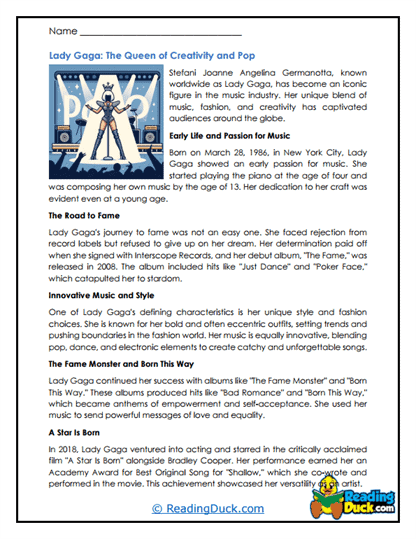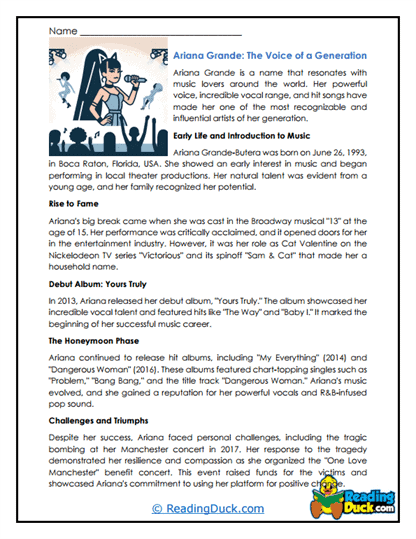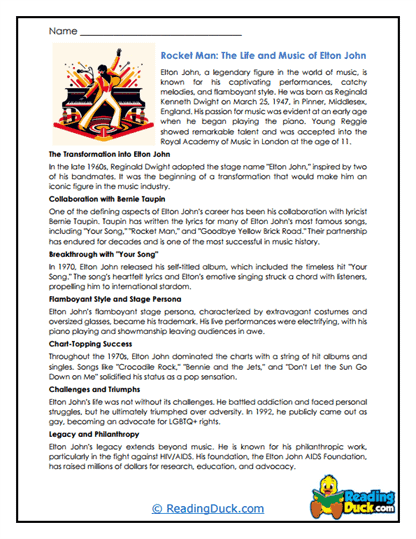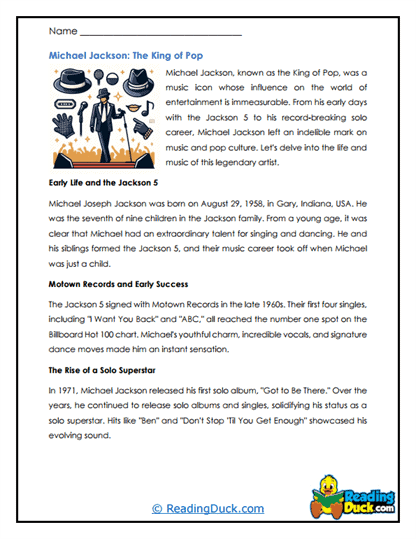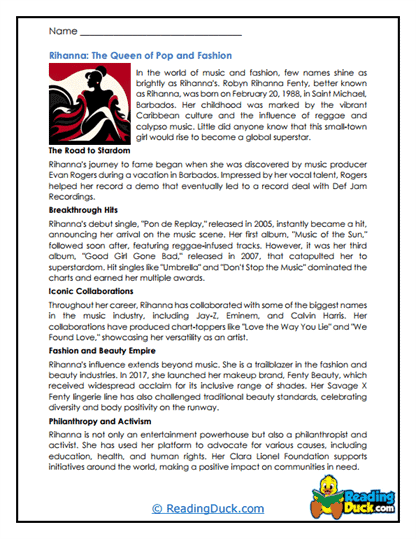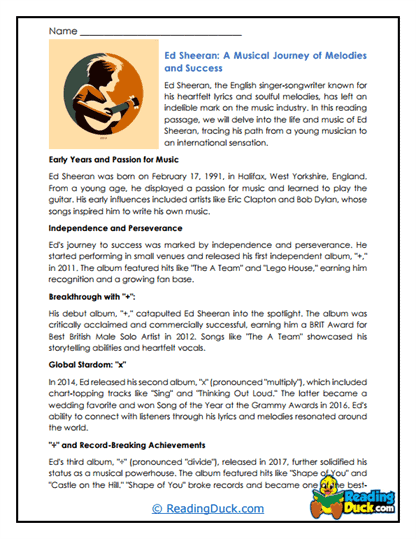Pop Artists Worksheets
About Our Pop Artists Worksheets
Our Pop Artists worksheets offer an engaging and comprehensive exploration of some of the most influential figures in pop music history. Pop music, with its catchy melodies, relatable lyrics, and widespread appeal, has been a defining force in the music industry for decades. These worksheets are designed to help students appreciate the creativity, technical skill, and cultural impact that pop artists bring to the music world.
Each topic in our Pop Artists collection contains several worksheet sets, each crafted to build students' understanding and connection to the material through a variety of engaging activities. These sets include:
- Multiple Choice Questions: These questions assess students' comprehension of the reading passages, focusing on key facts about the artist's life, career, and contributions to pop music. This format helps reinforce students’ understanding and encourages them to engage with the material in detail.
- Short Answer Questions: This format challenges students to reflect on what they’ve learned by writing their responses in their own words. These questions encourage deeper thinking and help students articulate their thoughts and insights about the artist's influence and style.
- Open-Ended Questions: These questions invite students to explore their personal responses to the material, asking them to express opinions, preferences, or interpretations related to the artist's music and legacy. This format fosters critical thinking and allows students to connect with the content on a more personal level.
Each worksheet set is designed to assess students’ understanding while enhancing their engagement with the topic. An answer key is provided for every question sheet, making it easy for educators to review and evaluate students’ progress. All worksheets are available as PDF files, which can be easily viewed electronically, downloaded, and printed.
Chart-Toppers and Cultural Icons: The Influence of Pop Artists
Pop music is a genre that has consistently captivated audiences across the globe, blending elements from various musical styles to create a sound that is both accessible and impactful. When introducing students to the world of pop artists, it’s essential to highlight how these musicians have not only entertained millions but have also influenced fashion, culture, and social movements. From the golden era of pop in the 1960s to the digital age of the 21st century, pop artists have continuously reinvented the genre to reflect the changing tastes and values of society.
Key Aspects of Pop Artists:
- The Evolution of Pop Music: Pop music has evolved significantly over the decades, shaped by technological advancements, cultural shifts, and the creativity of its artists. From the Beatles’ innovative use of studio technology to Michael Jackson’s groundbreaking music videos, each era of pop music has brought something new to the table. Students should understand how pop music reflects the trends and issues of its time, making it a mirror of societal changes.
- Pioneers of the Genre: The history of pop music is marked by the contributions of pioneering artists who have shaped its sound and expanded its reach. Icons like Madonna, Prince, and Whitney Houston brought pop music to new heights with their unique styles, stage presence, and musical innovations. These artists not only defined the sound of pop music but also influenced fashion, dance, and even social norms.
- Modern Pop Stars: Today’s pop music continues to evolve with artists like Taylor Swift, Beyoncé, and Ed Sheeran leading the way. These modern stars have broadened the appeal of pop music by blending elements of other genres, such as R&B, hip-hop, and electronic music, to create a sound that resonates with a global audience. Understanding the contributions of these artists helps students see how pop music remains relevant and dynamic in today’s music scene.
- The Role of Lyrics and Imagery in Pop Music: Pop music is often characterized by its relatable lyrics and strong visual imagery. Whether it’s a love ballad or an anthem of empowerment, pop songs often tell stories that resonate with a wide audience. Students should explore how pop artists use lyrics and visuals to convey messages, create personas, and connect with their fans on an emotional level.
- Cultural Impact and Legacy: Beyond the music itself, pop artists have had a profound impact on culture. Their influence can be seen in fashion trends, dance styles, and even social movements. For instance, the fashion statements made by artists like Lady Gaga and David Bowie have inspired entire subcultures, while the activism of artists like Bono has raised awareness about global issues. Recognizing the cultural significance of pop artists helps students see the broader impact of music on society.
- The Business of Pop Music: Pop music is also a major force in the global entertainment industry. The success of pop artists is often tied to their ability to market themselves, build a brand, and connect with fans through various media platforms. Students should understand how the business side of pop music, including record labels, streaming services, and social media, plays a role in shaping the careers of artists and the popularity of their music.
By exploring these key aspects of pop artists and their contributions to music, students can develop a well-rounded understanding of the genre and its significance. They will learn to appreciate the technical skills, creativity, and cultural impact that pop artists bring to the music world. This knowledge not only enhances their musical education but also fosters a deeper connection to the music they listen to and enjoy.
The Importance of Music Education
Music education is essential for students of all ages because it nurtures creativity, enhances cognitive development, and provides a means of emotional expression. Learning about music, whether through playing an instrument, understanding music theory, or studying influential musicians, helps students develop skills that are transferable to other areas of life. It encourages discipline, perseverance, and teamwork, while also improving memory and problem-solving abilities.
Moreover, music education allows students to explore their own creativity and connect with others on a deeper level. It fosters an appreciation for different cultures and histories, as music often reflects the values and experiences of diverse communities. By studying music and the artists who create it, students gain a greater understanding of the world around them, enriching their personal and academic development.
Integrating These Worksheets in a Curriculum
To effectively incorporate our Pop Artists worksheets into your curriculum, here are some tips for teachers and parents:
- Thematic Lessons: Create themed lessons around specific eras or movements within pop music. For example, explore the British Invasion of the 1960s, focusing on how artists like The Beatles and The Rolling Stones influenced the global music scene.
- Comparative Analysis: Encourage students to compare and contrast the styles and techniques of different pop artists. This could involve examining how the sound of 1980s pop differs from today’s pop, or how various artists have addressed similar themes in their music.
- Interactive Listening Sessions: Pair the worksheets with listening sessions where students can hear the pop artists in action. Use audio or video recordings to showcase the musicians discussed in the worksheets, helping students connect the theoretical aspects of their studies with the actual sound and feel of the music.
- Creative Projects: Assign creative projects where students can write their own pop song lyrics, analyze the production techniques in their favorite pop tracks, or create a presentation on their favorite pop artist. These hands-on activities allow students to apply what they’ve learned in a practical and engaging way.
- Cross-Disciplinary Connections: Link the study of pop artists with other subjects such as history, social studies, or media studies. For example, discuss how the social and political climate of the 1980s influenced the music of artists like Madonna and Michael Jackson, or explore the role of music videos in shaping popular culture.
- Group Discussions: Use the open-ended questions in the worksheets as prompts for group discussions. Encourage students to share their thoughts on the music, the musicians, and the cultural impact of the pop artists they are studying. These discussions can help students develop critical thinking skills and learn to articulate their opinions effectively.
- Assessment and Feedback: Use the multiple choice and short answer questions to assess students’ understanding of the material. Provide personalized feedback that highlights their strengths and areas for improvement, helping them grow as both students and music enthusiasts.
By using these strategies, teachers and parents can help students gain a deeper understanding of pop music, develop critical listening skills, and foster a lifelong appreciation for the genre. The Pop Artists worksheets are a valuable resource that can be integrated into a variety of educational settings, making music history and theory accessible and engaging for all students. Through consistent practice and exploration, students will not only learn about the great pop artists of the past and present but also develop a greater appreciation for the art of music itself.



